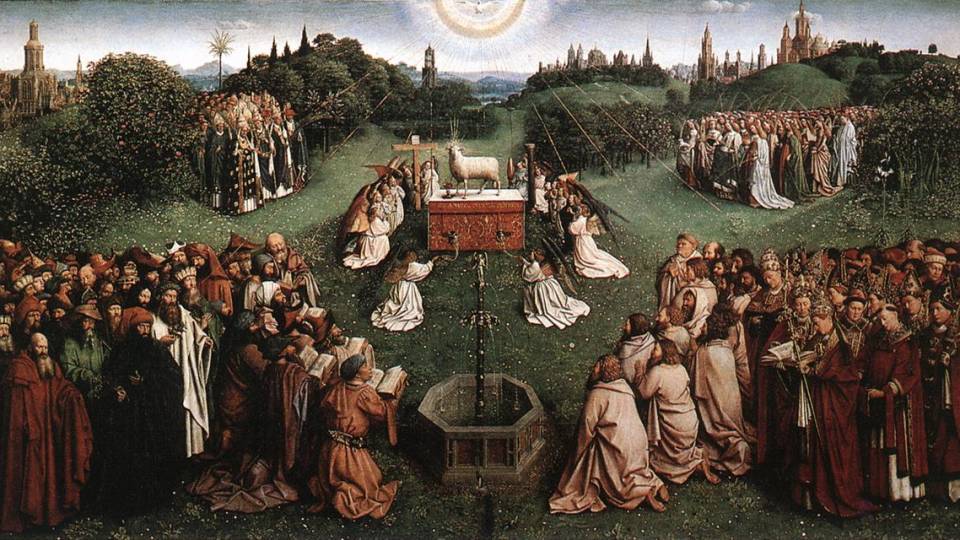

Communion: the wedding feast of the Lamb
Prof. Anna Rowlands
Friday, October 13, 2023
 The Ghent Altarpiece: Adoration of the Lamb (Source: Wikimedia Commons)
The Ghent Altarpiece: Adoration of the Lamb (Source: Wikimedia Commons)
Communion: the wedding feast of the Lamb
Theological Input
Dear Holy Father, brothers and sisters, Can we find the courage to encounter reality, as it really is? This was Fr Timothy’s beautifully challenging question to us. He placed before us the paradox of our call to be Christ like: to hear, see and feel the condition of our world, and yet to be gently honest with ourselves that we do not find bearing reality so easy. Section B1 of the Instrumentum Laboris leads us into the heart of this basic Christian paradox: hope and difficulty, the beauty and freedom of God’s call and the challenges of growing into holiness. The Instrumentum Laboris uses the language of Lumen Gentium § 1 – inviting us to reflect on the mission of the Church to be in Christ the sign and instrument of unity with God and all humanity. The life of communion is given to us as the graced way of living together in Christ, learning to ‘bear with’ reality, gently, generously, lovingly, and courageously, for the peace and salvation of the whole world. The first thing to say about communion, then, is that it is the reality of God’s own life, the being of God, Father, Son and Holy Spirit. In this sense, it is the most real thing there is: the ground of reality and source of the being of the Church. Our first action in relation to this reality is a joyous, non-anxious, non-competitive reception. To participate in the life of communion is the honour and dignity of our lives. Communion is how we understand God’s ultimate purpose for all humanity: to draw the creation he loved into being ever more completely into His own life, in embrace, and through so doing, to send us out to renew the face of the earth. The call to be the Church that serves this kingdom is described in Lumen Gentium § 9: “that it may be for one and all the visible sacrament of this saving unity”. The Church both shows and gives communion with God, who is communion for all creation. Communion is then our being and our doing. A friend tells me that Raymond Brown, the American biblical scholar, was fond of teaching his students that the language of koinonia first appears in the New Testament in connection with the practice of money exchange, expressing the idea of the Church’s common pot. The money – the currency of the Church is not cash – rather, our common pot is the riches of the gifts, charisms and graces God pours out in the Church, which he “distributes […] with his own authority” (Bas., fid. 3), and we are called to discern. As baptised Christians, we all have our hand in this pot. We think of communion as both the first and last words for a synodal process: the origin and horizon of our path. With Christ and his Spirit at the centre, communion is the very power of this room. The joke often made is that God became flesh, and the theologians turned God back into words again… and my time is short, so I will choose just three different dimensions of thinking about communion to name very briefly. Firstly, communion is the beauty of diversity in unity. In a modern world that tends towards both homogeneity and fracture, communion is a language of beauty, a harmony of unity and plurality. This beauty lies in its celebration of the richness and diversity of a creation that gives glory to God, a plurality that finishes only when each created thing has exhausted its createdness, and all is enfolded back into God through Christ in the Spirit. St Bonaventure, the great Franciscan theologian, wrote beautifully about how creation’s plurality allows all the different colours of the divine light to shine through. The divine light is perceived in a communion that radiates through a glorious diversity – of persons, creatures, cultures, languages, liturgies, gifts and charisms. Henri de Lubac emphasised that the Church is never in competition with culture. In the cultures she dwells in, She confesses and receives Christ. A communion that radiates is a non-competitive, genuine diversity with a single point of unity in the Trinitarian God. In the face of a worldliness which so often worships competitive and assertive strength and the logic of possession rather than relation, God draws us into a communion of humility and service. Jean-Marie Tillard wrote that, unlike any other entity in the world, it is in embracing weakness, in suffering and in poverty that the Church ‘succeeds’ in becoming the sign of God’s grace. Our beauty is not the world’s beauty. Section B1 invites us to grow in communion by reflecting with humility with those who are vulnerable, suffering or weak and on the vulnerabilities and weaknesses of the Church. In Section B1, we ask with courage how we might be closer to the poorest, more able to accompany all the baptised in a variety of human situations, disposed of false power, closer to our fellow Christians, and more engaged with our particular cultures. The Church was born inseparable from the human drama: in a temporary shelter, on the Cross, at Pentecost. Our Catholicity continues to be lived amidst our human drama. We speak of communion, not out of a calm perfection that lies just out of our reach, but out of our necessary location in the struggle of every culture and context for truth, beauty and goodness. Section B1 invites us to reflect positively on the meaning we find in those places of encounter and struggle, to hear echoes and differences. Secondly, communion exists in concrete, tangible realities. It is the life that offers bread for the hungry, healing for the suffering, rest for the troubled. Perhaps the most relatable and vivid image of communion is, as a feast, the wedding supper of the Lamb. God appeals to our senses: taste and see, take and eat. It is in the Eucharist that the different dimensions of communion meet: this is the place where the communion of the faithful is made manifest, where we receive the gifts of God for God’s People. The sacramental order teaches us, by feeding us, communion. The Scriptural portrayal of the feast is also an image that unsettles the perceived natural order of things. In the feast that is set, the powerless, despised and suffering shall be first. This is so, because of the closeness of God to those who suffer and the closeness of many who suffer to the knowledge and mystery of God. A survivor of clergy abuse wrote to me when he knew I would be at the Synod, he said, ‘be bold about the need for healing. This is a pascal journey we must walk together. And tell them the Eucharist is life saving.’ Not all abuse survivors feel this way, but I share this because it has the character of a prophecy of communion; it calls for repentance, and proclaims the central truth of our faith. The scandalous friendships of Jesus that drew a community of disciples together were so often table friendships. And table friendships matter. When I worked with a Catholic refugee charity in London, I asked the refugees who came for assistance why they chose this particular service. I will never forget their reply: because here I am welcomed at the door by name, and the staff sit and eat with us at the same table. This dignifies me, it gives me back my humanity. At the other centres, the staff do not eat with us. Worksheet B1.1 focuses our discussions on precisely these questions of a dignified communion where the Church encounters Christ who already sits at table with the poorest. Thirdly, communion is a participation that ties us to others across time and space. The koininia language of the Scriptures is instructive; it implies: ‘to share, to have a part in, to have something in common with, to act together’; a participation in a shared reality from which no one is, in principle, excluded. It is a reality that becomes more itself as it is poured out, extended outwards to every corner of the globe, and shared more intimately and completely between the Churches. Accepting truth means there is always more truth to know. We are always acting in the light of what has been, acting now, and acting towards what beckons – towards unity and service of the kingdom. Each of these actions - started but incomplete – tie us to the realities of the past – the joyful ones that need to be sustained, the harmful ones that need to be repented and healed – the praise of God and call of our neighbour in the present, and the future we long to be received into. A crucial part of why communion language is Pascal and therefore hopeful language is because it ties past, present and future with a golden thread. In an age often intent on severing those connections, our faith holds tight to them. It is part of its orientating intelligence for us. This reality of a communion that radiates, mysterious yet utterly practical, already before us, and still ahead of us, offered as bread for the world and words that save lives, needing to be expressed in every context - local, regional, global - that the Church inhabits, this is the paradoxical horizon of hope, the reality that if we have the courage, the Lord invites us to place ourselves within.Related Articles:
<<
SUPPORT LABEL
$50
$100
$150
$250
OTHER AMOUNT
DONATE
Receive our newsletters
Stay Connected
Receive our newsletters

Stay Connected









